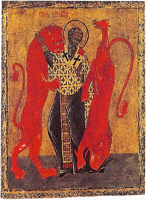A first-century Bishop of Antioch in Syria, Ignatius is said to have been appointed by St Peter and taught by St John. He was made a prisoner by the Roman authorities and brought to Rome to meet his end in the Colosseum, and owes his fame chiefly to the letters he wrote on the long journey, seven of which survive.
Ignatius of Antioch

| Life | 5 |
| Humility | 2 |
| Works | 2 |
| Martyrdom | 7 |
| Influence | 3 |
'I want no more what men call life.'
There is something rather unsettling about Ignatius' impatience to sacrifice his own life for the Church. It's hard to believe that he didn't have posterity in mind as well as the service of the Lord.
Ignatius' letters are significant because so little else survives from the first century of the Church's existence. Although they are relatively short, they shed much light on the theology of the early Church, as well as rejoicing in the glory of martyrdom.
In his letters, Ignatius explains that his thirst for martyrdom at some length, and implores his friends and fellow church leaders not to intercede on his behalf. He insists that even if the lions in the Colosseum turn out not to be hungry, he will force them to eat him anyway. It seems that, in the event, they were.
Early Christians were divided as to how to react to repeated persecution by successive Roman emperors. The Gnostics, who liked to portray their religion as a secret mystery, were often happy to keep their heads down and dissemble when accused of practising Christianity. The mainstream Church, by contrast, made a virtue of emulating the sacrifice that Jesus himself made. Ignatius' story was one of many that exemplified the ideal martyrdom.













